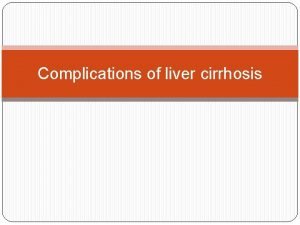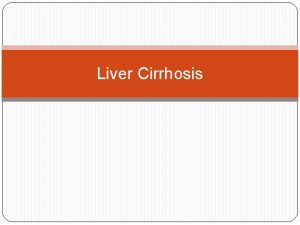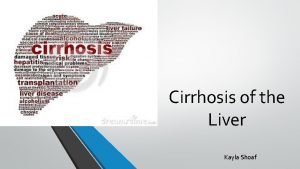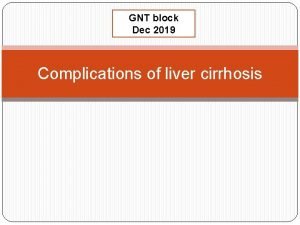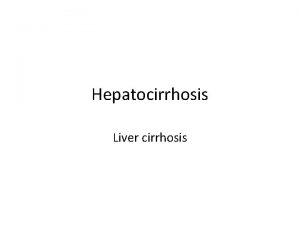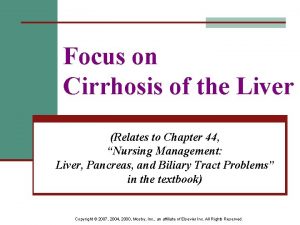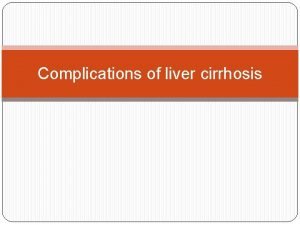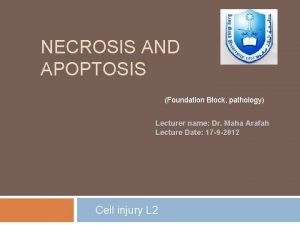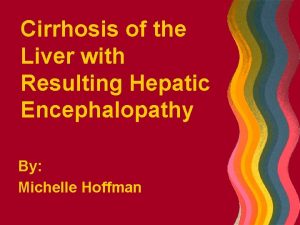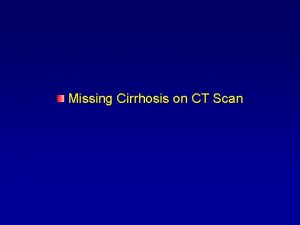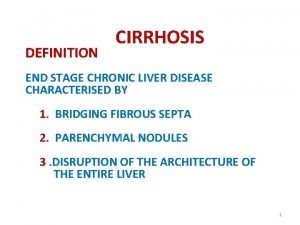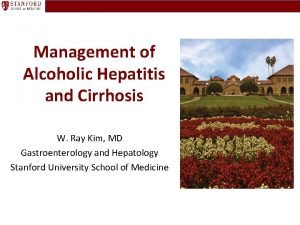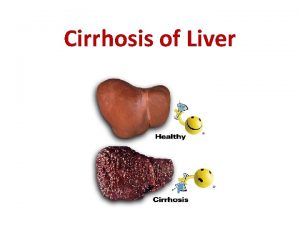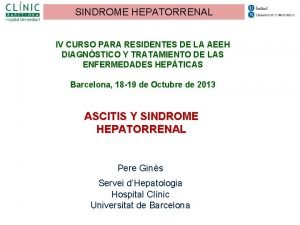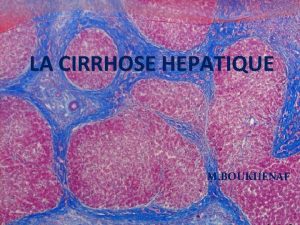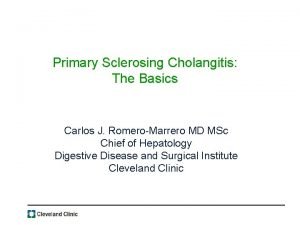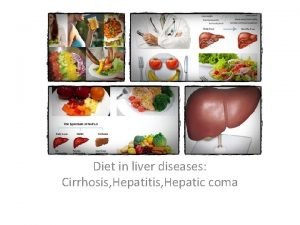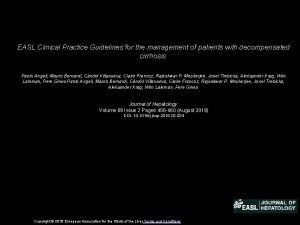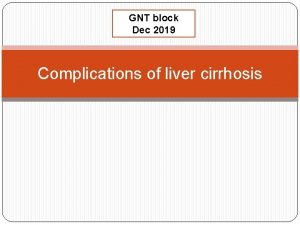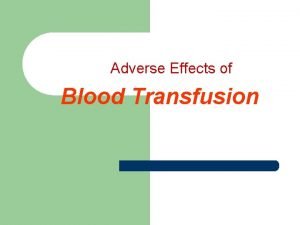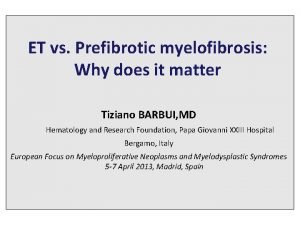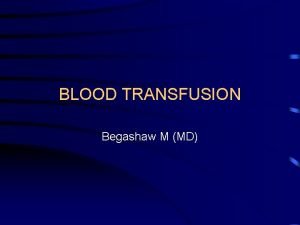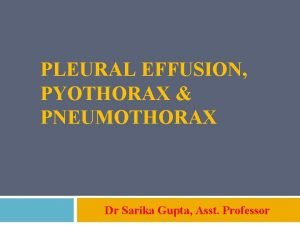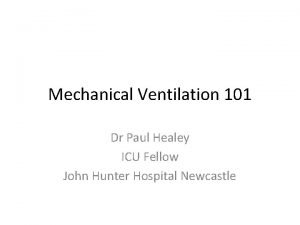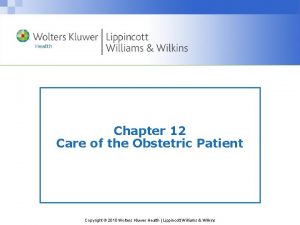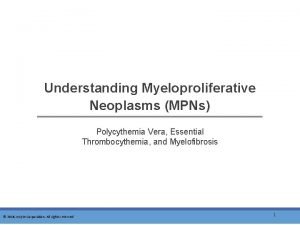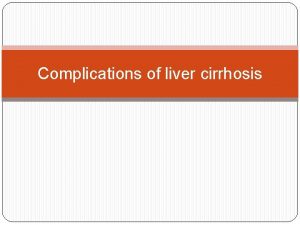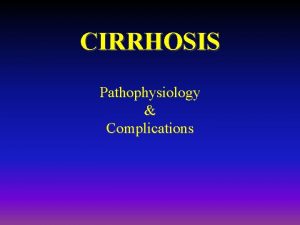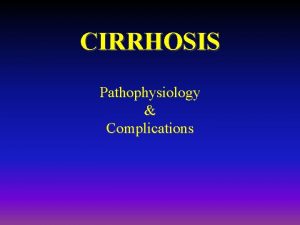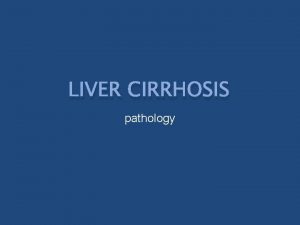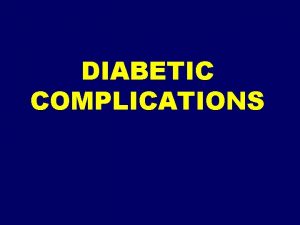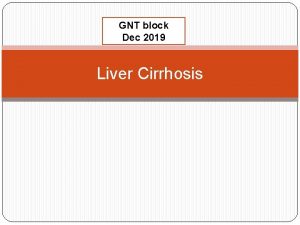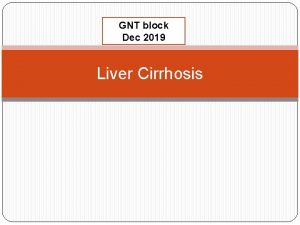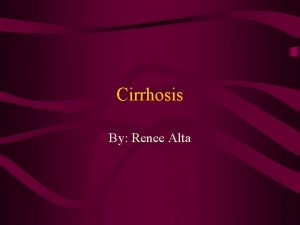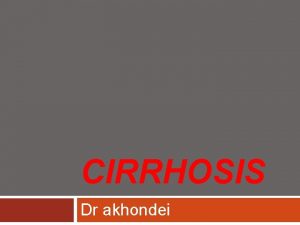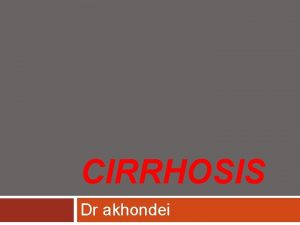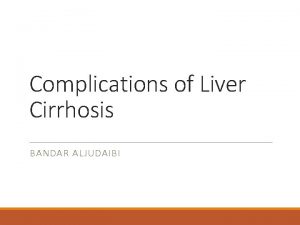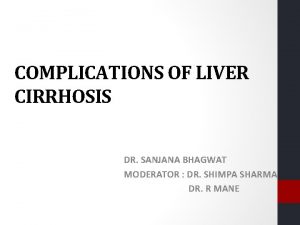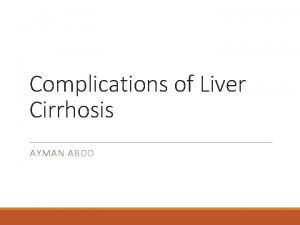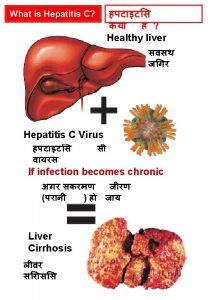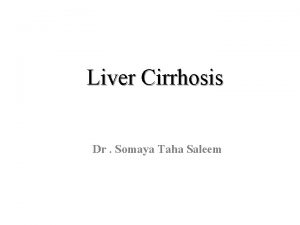Complications of liver cirrhosis Complications of liver cirrhosis






























- Slides: 30

Complications of liver cirrhosis

Complications of liver cirrhosis �Recognize the major complications of cirrhosis �Understand the pathogenetic mechanisms underlying the occurrence of the complications �Recognize the clinical features inherent to the above mentioned complications �Describe the pathological findings of the different complications

. Complications of liver cirrhosis � Portal hypertension � Variceal bleeding � Splenomegaly � Ascites � Spontaneous bacterial peritonitis � Jaundice and cholestasis � Coagulopathy � Hepatic encephalopathy � Hepatorenal syndrome � Hepatocellular carcinoma

Complications of liver cirrhosis PORTAL HYPERTENSION :

Complications of liver cirrhosis PORTAL HYPERTENSION : �Resistance to blood flow prehepatic, intrahepatic, and posthepatic �The dominant intrahepatic cause is cirrhosis (This is accounting for most cases of portal hypertension) �Portosystemic shunts develop when blood flow is reversed from the portal to systemic circulation.

Complications of liver cirrhosis ESOPHAGEAL VARICES

Complications of liver cirrhosis ESOPHAGEAL VARICES: �Instead of returning directly to the heart, venous blood from the GI tract is delivered to the liver via the portal vein before reaching the inferior vena cava. � This circulatory pattern is responsible for the first-pass effect in which drugs and other materials absorbed in the intestines are processed by the liver before entering the systemic circulation. .

Complications of liver cirrhosis ESOPHAGEAL VARICES: �Diseases that impede this flow cause portal hypertension and can lead to the development of esophageal varices, an important cause of esophageal bleeding

Complications of liver cirrhosis Portal hypertention Portosystemic Shunt Rectum ( hemorrhoids) Cardioesophageal junction ( esophagogastric varices) Abdominal wall collaterals (caput medusae)

Complications of liver cirrhosis ESOPHAGEAL VARICES: Pathogenesis �Portal hypertension results in the development of collateral channels at sites where the portal and caval systems communicate. Although these collateral veins allow some drainage to occur, they lead to development of a congested subepithelial and submucosal venous plexus within the distal esophagus. (varices) �Varices develop in 90% of cirrhotic patients mostly in association with alcoholic liver disease �Hepatic schistosomiasis

Complications of liver cirrhosis ESOPHAGEAL VARICES Morphology: � Varices can be detected by venogram: tortuous dilated veins lying primarily within the submucosa of the distal esophagus and proximal stomach. Venous channels directly beneath the esophageal epithelium may also become massively dilated. � Varices may not be grossly obvious in surgical or postmortem specimens, because they collapse in the absence of blood flow. � Variceal rupture results in hemorrhage into the lumen or esophageal wall, in which case the overlying mucosa appears ulcerated and necrotic. If rupture has occurred in the past, venous thrombosis, inflammation, and evidence of prior therapy may also be present.

Complications of liver cirrhosis ESOPHAGEAL VARICES: Clinical features: �Asymptomatic or rupture- massive hematemesis. �Inflammatory erosion of thinned overlying mucosa �Increased tension in progressively dilated veins �Increased vascular hydrostatic pressure associated with vomiting are likely to contribute to medical emergency that is treated by any of several methods: 1. Sclerotherapy 2. Endoscopic balloon tamponade 3. Endoscopic rubber band ligation

Complications of liver cirrhosis ESOPHAGEAL VARICES: �Half of patients die from the first bleeding episode either as a direct consequence of hemorrhage or following hepatic coma triggered by hypovolemic shock. �Additional 50% within 1 year. �Each episode has a similar rate of mortality. �Over half of deaths among individuals with advanced cirrhosis result from variceal rupture.

ESOPHAGEAL VARICES: Complications of liver cirrhosis

Complications of liver cirrhosis �Splenomegaly: Long-standing congestion may cause congestive splenomegaly (spleen weight may reach up to 1000 gm) �The massive splenomegaly may induce hematologic abnormalities attributable to hypersplenism, such as thrombocytopenia or pancytopenia

Complications of liver cirrhosis �Ascites is the accumulation of excess fluid in the peritoneal cavity: � 85% of cases are caused by cirrhosis �Serous: less than 3 gm/d. L of protein

Complications of liver cirrhosis �Spontaneous bacterial peritonitis

Complications of liver cirrhosis JAUNDICE AND CHOLESTASIS

Complications of liver cirrhosis JAUNDICE AND CHOLESTASIS: �Jaundice and icterus: a yellowish or greenish pigmentation of the skin and sclera of the eyes respectively due to high bilirubin levels. �Cholestasis, characterized by systemic retention of not only bilirubin but also other solutes eliminated in bile.

�Bilirubin metabolism and elimination

Complications of liver cirrhosis Cause of Jaundice 1. Prehepatic causes of jaundice: Bilirubin overproduction due to hemolysis and hematoma resorption, lead to elevated levels of unconjugated (indirect) bilirubin. 2. Intrahepatic disorders can lead to unconjugated or conjugated hyperbilirubinemia. The conjugated (direct) bilirubin level is often elevated by alcohol, infectious hepatitis, drug reactions, and autoimmune disorders. 3. Posthepatic disorders (Obstruction of the flow of bile) also can cause conjugated hyperbilirubinemia. Gallstone formation is the most common posthepatic process that causes jaundice; however, the differential diagnosis also includes serious conditions such as biliary tract infection, pancreatitis, and malignancies

Complications of liver cirrhosis Coagulopathy

Coagulopathy �The liver is the source of a number of coagulation factors that decline in the face of liver failure, leading to easy bruising and bleeding

Complications of liver cirrhosis Hepatic encephalopathy

Complications of liver cirrhosis Hepatic encephalopathy �spectrum of disturbances in consciousness ranging from subtle behavioral abnormalities, to confusion and stupor, to coma and death. �may develop over days, weeks, or a few months �Due to elevated ammonia levels in blood and the central nervous system and brain edema.

Complications of liver cirrhosis Hepatorenal syndrome:

Complications of liver cirrhosis Hepatorenal syndrome: �Appearance of renal failure in individuals with severe chronic liver disease --- no intrinsic morphologic or functional causes for the renal failure. �The incidence of this syndrome is about 8% per year among patients who have cirrhosis and ascites

Complications of liver cirrhosis Hepatorenal syndrome: �Decreased renal perfusion pressure due to systemic vasodilation �Activation of the renal sympathetic nervous system with vasoconstriction of the afferent renal arterioles �Increased synthesis of renal vasoactive mediators, that decrease glomerular filtration.

Complications of liver cirrhosis �Hepatocellular Carcinoma

Complications of liver cirrhosis �Conclusion
 Complications of cirrhosis
Complications of cirrhosis Cirrhosis pathogenesis
Cirrhosis pathogenesis Pes statement for liver cirrhosis
Pes statement for liver cirrhosis Complication of liver cirrhosis
Complication of liver cirrhosis Hepatosirosis
Hepatosirosis Types of cirrhosis
Types of cirrhosis Complication of liver cirrhosis
Complication of liver cirrhosis Liquefactive necrosis
Liquefactive necrosis Liver cirrhosis stages
Liver cirrhosis stages Pes statement for liver cirrhosis
Pes statement for liver cirrhosis Stage 3 liver disease
Stage 3 liver disease Can ct scan miss cirrhosis
Can ct scan miss cirrhosis Hobnail fibrotic liver
Hobnail fibrotic liver Primary biliary cirrhosis
Primary biliary cirrhosis Cirrhosis
Cirrhosis What is cirrhosis
What is cirrhosis Cirrhosis care near woodland
Cirrhosis care near woodland Cirrhosis
Cirrhosis Micronodular cirrhosis vs macronodular
Micronodular cirrhosis vs macronodular What is biliary cirrhosis
What is biliary cirrhosis Diet hepatic encephalopathy
Diet hepatic encephalopathy Easl guidelines decompensated cirrhosis
Easl guidelines decompensated cirrhosis Hyperestrinism cirrhosis
Hyperestrinism cirrhosis Hemolytic transfusion reaction
Hemolytic transfusion reaction Prefibrotic myelofibrosis
Prefibrotic myelofibrosis Blood transfusion requirements
Blood transfusion requirements Light's criteria
Light's criteria Complications of mechanical ventilation
Complications of mechanical ventilation Complications of gestational diabetes
Complications of gestational diabetes White blood cells function
White blood cells function Bronchoscopy complications
Bronchoscopy complications
